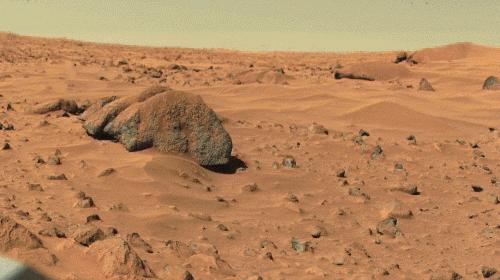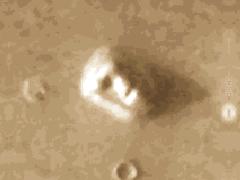pop up description layer
HOME
Cryptozoology UFO Mysteries Aviation Space & Time Dinosaurs Geology Archaeology Exploration 7 Wonders Surprising Science Troubled History Library Laboratory Attic Theater Store Index/Site Map Cyclorama
Search the Site: |
|
Life in our Solar System

The surface of Mars as seen from a Viking lander (NASA) Of the nine planets in our Solar System only two seem good candidates for life as we know it. The planet closest to the Sun, Mercury, is too hot. The next out, Venus, while it is very Earth-like in size and shape, has an average temperature of 475 degrees C (still too hot), and a lack of life giving water. Earth, of course, shows some signs of intelligent life. Mars, which we'll come back to in a moment, is the next. Beyond that the planets, with the exception of the last, Pluto, are gas giants (Jupiter, Saturn, Uranus and Neptune) who's high pressure atmosphere's and chill temperatures, though they don't rule out life, suggest it would be in a form much different than our own.
When large telescopes were first built a century ago, astronomers turned their attention towards Mars. Giovanni Schiaparelli, an Italian, published a series of observations he'd made of Mars including reports of canali (Italian for channels) he'd seen on the surface. When the word was improperly translated to English as "canals" it seemed to connote they were dug by intelligent life. Later on Percival Lowell, who studied Mars for decades from his observatory in Flagstaff, Arizona, furthered this idea of canals and suggested that they were dug by intelligent beings. Others even suggested that the Martian moons were really artificial satellites.
More careful observations in this century show that the "canals" once seen do not seem to match surface features actually on Mars. The best explanation for the earlier observations are wind storms that cover and uncover darker rock of the surface with lighter colored sand.
Close observations of Mars via probes (including landers on the surface) have failed to find any trace of intelligent life or it's remains. (Strangely enough the best evidence for life on Mars was discovered back on Earth) But robot observers and landers have found the marks of dry stream beds indicating that water, a requirement for all Earth life, once flowed on the surface. Now the planet seems dry. Martian temperatures can get as warm as 70 degree Fahrenheit under the best conditions, but usually stay below freezing. The air is thin and unbreathable by our standards. These factors do not completely rule out life and the Viking 1 and 2 landers attempted to sample the soil to look for signs of organic activity. Most of the tests came back negative and the single positive test may be the result of an unusual chemical reaction taking place in the soil. Again the tests do not completely rule out primitive life on Mars as only a small portion of the surface was examined. Photographs of the terrain of Mars did uncover an unusual feature: a cluster of hills that, when seen with the Sun at a particular angle, resembles a face. Nearby are other features that look like pyramids. Some have interpreted these as sculptures by Martians similar to the giant figures etched in the ground on Earth in such places as Nazca, Peru. It is much more likely, though, they are a fully natural phenomenon not unlike shapes or faces often seen, by imaginative humans, on Earth in mountains or hills.
There is also one surprise candidate for life in our solar system. Far out beyond the orbit of Mars lies the largest planet in our solar system, the gas giant, Jupiter. One of it's fourteen plus moons, Europa, seems to be covered with smooth, but cracked ice. Scientists have suggested that the tidal forces on Europa (caused by the pull of Jupiter's gravity and the motion of the moon's orbit) may give this Europa a hot core. If that is true there may be liquid water below Europa's ice shell. Hot volcanic vents on this ocean floor might be an environment that would enable life forms similar to the creatures that populate thermal vents in Earth's oceans to survive. It seems unlikely though, if these creatures exist, that they are operating flying saucers.
Copyright Lee Krystek 1996. All Rights Reserved. |
{
|
Related Links |
|
|






